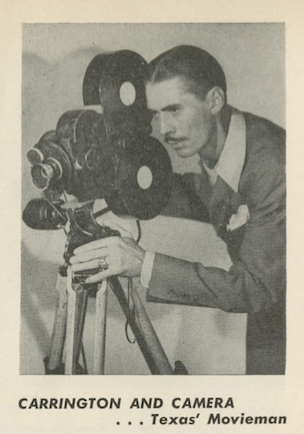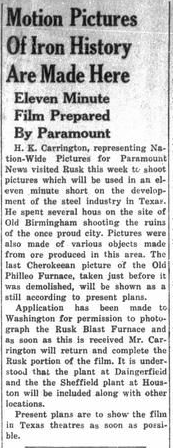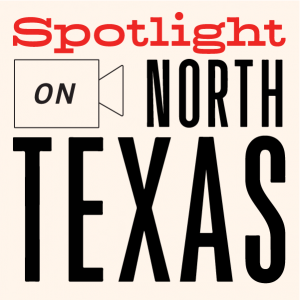Local film productions have the capacity to reveal landscapes, architectures, and traditions that are no longer viewable in present day cities. Often shot by local crews and featuring local actors, these movies give us a visual representation of historical landscapes, events, and people that are not always depicted in nationally produced materials. Many of these films were produced in Dallas movie studios, shot on location in North Texas, distributed through Dallas film exchanges, and shown at Dallas movie theatres.
Unfortunately, many of these buildings have been demolished and many of these films are lost or missing. This appears to be the case for Dallas filmmaker, H. K. Carrington who made a living filming Texas. With the exception of the short film “Texomaland,” located in the UNT Media Library’s 16mm film collection, I have been unsuccessful in my search to locate copies of Carrington’s Texas-based film series.
A Texan By Choice
Information about Carrington and his films is difficult to piece together. Texas Week, a local news magazine, reported in 1946 that H. K. Carrington was “born at the turn of the century, educated in England, France and America, and graduated by Harvard with a degree in electrical engineering.” He was reportedly an employee of Bell Telephone Laboratories in New York before the “lure of show business beckoned” and he became a director or cameraman for motion pictures. What follows is a brief history of the films Carrington made in and about Texas pieced together from local newspapers and trade magazines. We hope to find other local films like these at our media preservation event, “Spotlight on North Texas.”

“Texas is to have its own newsreel. Produced in Texas, of Texas, and for Texans.”
During the 1930s and early 1940s, Carrington worked as a traveling cameraman and supervisor at Nationwide Pictures, shooting popular newsreel series about the history and landscapes of the United States including “See America First,” “Great Moments in American History,” and “Skylines of America.” These films, a sort of travelogue and state history lesson, were distributed across the country and told the histories of exotic places like Twin Falls, Idaho. It was while working on these pictures, possibly while shooting a film about the 1939 Galveston Oleander Festival, that Carrington became fascinated with the history and traditions of the state of Texas and first dreamed of the possibility of a newsreel devoted only to Texas.
Carrington established a Nationwide Pictures unit in Dallas, Texas with the plan to produce a monthly newsreel, “This is Texas.” The whereabouts of the film studio has not been confirmed and various newspaper reports have it located at the Melba Theatre Building, Jackson Street, or even in Grand Prairie. The Kingsville Record reported in April 1942 that these newsreels would “bring to the screen many and varied pictures of unusual and interesting events, people, occupations, and places which serve to make Texas the grandest station in the nation.” The film studio was reportedly offering Texans $10 in cash for ideas and were “especially interested in unusual people, odd and different occupations, places of historical significance, and, in fact, all sorts of oddities.”
This is Texas
Carrington and his crew shot three or more short films in 1945 – 1946, but these films were apparently not distributed until 1948 and 1949. In the fall of 1948, Television Enterprises acquired exclusive world television and non-theatrical rights to “This is Texas.” The deal included six one-reel films per year over the next 5 years. Showmen’s Trade Review columnist Jack Jackson reported on June 25, 1949 on the activities of Carrington and Nationwide Picture, noting that Carrington “conceives the ideas, writes the script, turns the camera crank, edits, and cuts the film and then goes about the job of arranging playdates for short subjects.” He reported that Carrington was about to engage in a 4-city world premiere of a 10-minute picture and “has been hipped on the idea of getting a series of shorts ‘This is Texas,’ on the screens of the big state’s theatres for some time, and has spent many dollars and far more hours banging his noggin against that immovable wall of circuit indifference.” He said Carrington had gone to “executives of the State of Texas and wangled permission to put his reels into school film libraries on a sponsor basis–some firm buying the reel and donating to schools in return for a credit frame–and this seemed the turning point.” Jackson reported that
Invisible Rivers (ca. 1945, 10 min., B&W, Sound): A guide to the city of New Braunfels and the big springs of Texas.

Swords and Plowshares (ca. 1945, 10 min., B&W, Sound): The film was to show the history of the iron and steel industries in the Southwest from the Civil War era to present. According to a May 1945 news story in the “Rusk Cherokeean,” Carrington spent several hours shooting the site of Old Birmingham and would be filming at the Dangerfield and Sheffield plants in Houston. Carrington was to return to Rusk after receiving permission to shoot the Rusk Blast Furnace. The completed film was released for a week-long run in Dallas in December 1946.
Unknown (ca. 1945): The Fort Stockton Pioneer reported on Friday July 13, 1945 that Carrington’s Nationwide Pictures was in town and had shot footage of Comanche Spring and Rooney Park for a short feature “on points of interest, mainly water scenes, about Texas.” The Pioneer reported that Carrington’s cameraman “added local color with several pictures of a Pecos County donkey, with Miss Florence Potter, daughter of Mrs. J.A. Campbell,as the rider.”
The Bells of Tejas (ca. 1946, 10 min., B&W, Sound): This film concerned the 8 remaining Franciscan missions built in Texas and was filmed in Yaleta, Socorro, Goliad, and San Antonio. The Showmen’s Trade Review reported on 05/15/48 (p.15) that Jim Preddy of the Telenews Theatre in Dallas had orchestrated for his showing of the film “an exploitation campaign that rivaled the one for his feature, Universal-International’s ‘Black Narcissus.’” The Review reported that Preddy had mailed out 500 letters to churches, schools and clubs which “called attention to the short’s story of the religious influence and cultural backgrounds which commenced in the early days of the Tajos (Texas) people and continues to the present time, emphasizing the fact that it is the first picture dealing with the religious influence of the early Tajos.”
Unknown (1948): While shooting footage for the Lone Star Riders (see below), Carrington was reportedly shooting a film about ranching in the Panhandle, starring cover model Jinx Falkenberg. The January 04, 1948 Amarillo Globe quoted Carrington as saying “It is beginning to look like the Panhandle has about everything in the way of locale for a Western and we are looking forward with a great deal of pleasure to our stay in Amarillo.”
City of Contrast (ca. 1949, 10 min., B&W): This film reportedly features San Antonio, Texas and the influence of its Spanish heritage.
Spanish Texas (ca. 1949): This film reportedly showed the influence of Spain and Mexico on the Southwest and included dramatic historical recreations.
Texomaland on Digital Library.
Texomaland (ca. 1949): This film shows the recreational opportunities to Texans at the Texomaland Dam. Showmen’s Trade Review columnist Jack Jackson reported on June 25, 1949 that the film would have a release in four “fair-sized cities–and maybe Dallas–with two big circuits, Interstate and R&R participating.” Of the promotional campaign, Jackson reported “Carrington has practically every merchant in the cities surrounding Texhoma Lake cooperating and a string of activities including parades, Queen contests, etc., that would do credit to the most impressive of Hollywood’s super attractions lined up to build interest and attract patronage.”
Town and Country (ca. 1950, 10 min.) This film, partially shot in Kerrville, Texas, contrasted the everyday ranch life of West Texas with dude ranching and ended in a Western style wedding on horseback. The Kerrville Mountain Sun reported (04/27/1950), that the film had a sneak preview for about 20 people including the film’s local actors and members of the Junior Chamber of Commerce who assisted in the production.The Sun reported that Dr. P.B. Hill, Adam Wilson III, and about 50 other people were featured in the wedding scene. The movie would have a local premiere at The Arcadia, be reduced to 16mm size for school distribution, and have a minimum television showing of 31 stations. After the film opened in Kerrville, the Harrington family came to the Bantex theatre in Bandera for a screening of “Town and Country.” According to The Bandera Bulletin (Friday 4/28/1950) the film “presented a short sketch of the Hill Country, showing scenes on the Flying L Ranch, Mayan Ranch, Lost Valley, Circle R and other guest ranches in this section. Among the interesting scenes were activities on the various ranches, plus a western wedding which took place at Kerrville with the famous cowboy preacher, Dr. P.B. Hill, officiating. The Decatur Wise County Messenger advertised on 5/25/50 that the film had it’s world premiere that day at the Plaza Theatre.
Other Nationwide Films about Texas
The Magic Valley (ca. 1947, Color, Sound): Nationwide traveled in early 1947 to Brownsville, Texas to film the Rio Grande Valley and the February 1947 Charro Days Festival. According to the Brownsville Herald (02/09/1947), the film would show the “color and fantasy of the celebration with emphasis on costumed pageantry, the Grand parade, and the Children’s Parade, and the international [illegible] of the Fiesta.” However, the majority of the film would “consist of a colorful pictorial record, in sound and dialogue, of the palm-ringed, rich agricultural region along the northern bank of the Rio Grande.” It was said that the film would be “one of the most effective Valley advertising mediums ever produced, carrying the name of the Rio Grande Valley to big cities and little villages from Maine to California.” The script was to be written by Brownsville advertising man Welch Richardson and Brownsville Herald reporter Wallace R. Johnson.
Skylines of America
American Riviera (1951): Carrington and his wife traveled to Gulfport, Mississippi in October 1950 to work on this picture which would also include Biloxi and the Gulf Coast. The Gulf Park College student newspaper, The Tammy Howl, reported (11/25/50) that the Carrington’s visited the campus on Wed 10/11 and Thursday 10/12/1950 to shoot classroom and campus scenes. The Carrington’s visited with Dr. and Mrs. Hogarth in the college dining room and were introduced for the student body.
Bullets and Bibles (ca. 1952, ~12 min.): Possibly part of the “Skylines of America” series which were produced for television, this film reportedly featured the history and contemporary attractions of Waco, Texas. They would produce 16mm prints for television and 35mm prints for theatrical distribution.The Waco Tribune Herald reported (08/31/52) that the film would include the city’s major industrial plants, Baylor University, Browning Library, Waco Technical High School, Cameron Park, James Connally Air Force Base, and the Little Pentagon. On 8/31 they filmed a show staged for them by the Waco Longhorn Club and scenes at the Mission of St. Francis on Brazos, old and new homes, Lake Waco, Lovers Leap, and the Ridgewood Country Club. Footage was also planned of the Paul Quinn College, Old Waco Spring, and bridges across the Brazos River. According to the Waco Tribune Herald (05/02/1954), the film would have its premiere at the Orpheum Theatre with the feature “It Should Happen to You” on Friday 05/07/54. The film “takes its title from two qualities long associated with Waco history, it’s early reputation as a town where gunfights were accepted as the usual thing and, in contrast, its standing as a religious and educational center.” It appears that the film included a recreation of the William C Brann and Tom Davis pistol duel by members of the Waco Civic Theatre on the actual battle site, illustrations of the city’s industrial growth with scenes from the Wm. Cameron Mill, Owens Illinois Glass Plant, General Tire and Rubber Co., scenes of early and current agricultural practices,Waco ante-bellum and modern homes, and recreational facilities. Following the premiere, the film would be shown at the Westview and Oakland Drive-Ins as a companion feature with “The Naked Jungle,” “Ride Clear of Diablo,” and “It Came from Outer Space.”
Lone Star Riders
In 1947, Nationwide began planning a 6-episode fictional Western series, titled perhaps”Lone Star Riders” or the “Lone Rider.” The films would be released by Crystal Pictures Corp. of New York. Nationwide arrived in Amarillo for background sequences in January 1948. They were also searching for a new male star for their series. Clarence Jackson, owner of the Mayfair Nightclub, arranged for most of the shooting scenes in the Palo Duro Canyon and old ranches. Jackson’s club, redecorated as an old west saloon, was also the location of Carrington’s campaign to find a “typical Texas Couple” to take part in several of their films. For 14 nights in January 1948, local couples auditioned in front of audiences for the possibility of an all-expenses paid trip to Dallas for screen tests and possible roles in a future Western. Johnnie Prewitt and his Western Hits performed while Nationwide Director Harrol Perkinson directed the amateurs through a scene. Three months later, in April 1948, 14 screen tests were shown at the Mayfair over 6 nights. Each night the audience would be given one vote to select the Sweetheart of the Mayfair.
The American Little Theatre in Action
In the summer of 1952, Carrington began shooting a series of one-act plays produced by non-professional groups throughout the country. His first film was shot in Waco with plans to shoot productions by The Tyler Civic Theatre, The Daniel Baker College/Brownwood Civic Playhouse, and Hardon-Simmons University
Free for the Evening (1952, Color): The Waco Civic Theatre’s September 1952 production of Waco resident Charles Carver’s one-act play as directed by Norma Rhodes and starring Dee Voorhees, William Johnson, Harold Harrison, Robert Dupree, and Joann Sheev. The film was shot in color but would be distributed for television viewing in black and white. The film had its local premiere on December 19,1952 at the Waco Hall. Nationwide executives and crew members were on hand to orchestrate and events surrounding the premiere including local actors escorted in convertibles, luncheons, and press conferences. Prior to the filmed play, Carrington screened his short film about Biloxi, Mississippi, which would be part of the “Skylines of America Series.”
Join H. K. Carrington in Dallas motion picture history by sharing your home movies of Dallas and your photographs of Dallas area movie theatres with us on Saturday May 19th at Top Ten Records.
Learn More About the “Spotlight on North Texas” Program and follow us on Facebook and Twitter!



Leave a Reply